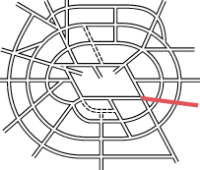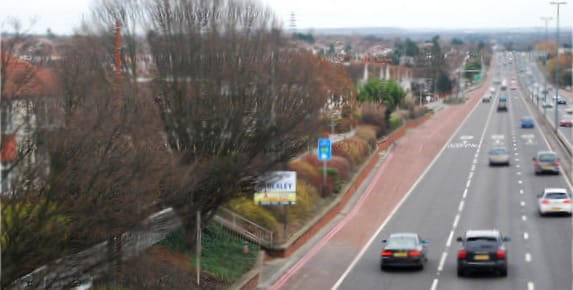This page is about abandoned proposals to incorporate the A2 into an urban motorway network for London. Information about the road as it exists today is in the Motorway Database.

London's ancient main road to Canterbury and Dover has been bypassed over and over again. Many of its planned improvements were finished in the end, even if they weren't the motorways envisaged in the sixties.
The A2 has its origins in Watling Street, the Roman Road from the port at Dover to London and on towards Wales. Since the early twentieth century it has seen almost continuous improvement works to handle modern traffic, and to tell the story of the A2 is really to tell the story of a series of confusingly overlapping bypasses.
The first were under construction before the number A2 had even been applied, and the earliest to open was the Dartford Bypass in 1924 - otherwise known as Princes Road, and now variously the A296, A225 and B2174. Another diversion, Rochester Way, carried the A2 past the steep Shooters Hill, but before that even opened work had started on another new road that branched off it, East Rochester Way. It extended the new arterial road past Bexleyheath and Dartford, and opened in 1928, bypassing the western end of the four-year-old Dartford Bypass.
Other plans were made, but that was the state of the A2 when planning for London's urban motorway network got under way. The new idea was to replace the road from New Cross to the Kent countryside with either a motorway or a road close to motorway standard. From Central London to New Cross the GLC would make only minor improvements as a Secondary Road.
From New Cross to Kidbrooke, the A2 would be bypassed by Ringway 1's South Cross Route. From there, the GLC planned a new motorway through Eltham called the A2(M) Dover Radial Route, which came extremely close to construction in the early 1970s before being called off. Those new roads would bypass the old A2 and Rochester Way, returning traffic to East Rochester Way at Falconwood Station.
Responsibility then switched to the Ministry of Transport, whose plans were quite different to the GLC's. Instead of a motorway, they would upgrade East Rochester Way on its existing line to produce something motorway-like but lined with semi-detached houses.
The plans may have been disjointed and controversial, but a surprising amount was finished and can be driven today: the Ministry completed their work on the A2 surprisingly quickly, and the Dover Radial Route was eventually built in watered-down form as the Rochester Way Relief Road. In fact, the only parts that are totally missing are the bits shared with the unloved and unbuilt Ringway 1.
Outline itinerary
R1 East Cross Route, R1 South Cross Route and A20(M) (Kidbrooke Interchange)
A205 Westhorne Avenue
R2 Eastern Section and R2 Southern Section (Falconwood Interchange)
A221 Danson Road (Danson Interchange)
Upton Road
A223 Bourne Road (Black Prince Interchange)
A2018 Old Bexley Lane (Dartford Heath Interchange)
R3 Eastern Section (Darenth Interchange)
Continues to Gravesend and Chatham
Cost summary
| Property acquisition (1970) | £4,500,000 |
| Rehousing (1970) | £500,000 |
| Construction (1970) | £20,150,000 |
| Environmental works (1970) | £105,000 |
| Total cost at 1970 prices | £24,755,000 |
| Estimated equivalent at 2014 prices Based on RPI and property price inflation | £191,783,888 |
See the full costs of all Ringways schemes on the Cost Estimates page.
Route description
This description begins at the western end of the route and travels east.
Kidbrooke to Dartford
From Central London to New Cross, the A2 would be an ordinary surface street, and through traffic would then use the New Cross Spur and South Cross Route to reach Kidbrooke. The A2's journey as part of the GLC's Primary Road Network would, therefore, only begin at Kidbrooke Interchange, the south eastern corner of Ringway 1, connecting the East Cross Route, South Cross Route and A20(M) Sidcup Link.
Two lanes of traffic from the South Cross Route would pass through the junction, and a third lane would join from the East Cross Route, to make a dual three-lane motorway, the A2(M), running alongside the railway line towards Eltham station.
An interchange at the A205 Westhorne Avenue would have only east-facing sliproads, with access towards London via the Yorkshire Grey junction on the nearby A20(M). The motorway would then descend into cutting, crossing to the south side of the railway and passing below the station and bus interchange at Eltham in a cut-and-cover tunnel.
All the houses on the north side of Glenlea Road would be demolished for the road, and it would take a slice off the edge of Eltham Park. At Falconwood a large free-flowing interchange would provide access to Ringway 2's Eastern and Southern Sections.
Here, the GLC's responsibility would end, and the road would lose motorway status, becoming the A2 as it joined East Rochester Way. This road was upgraded to provide three lanes each way with hardshoulders and motorway-style junctions in the 1960s, and exists today exactly as planned. It would continue towards Dartford as a huge expressway lined with houses. Interchanges would be provided with the A221 Danson Road and the A223 Bourne Road.
Emerging into open country, the road would become more rural in nature, still a three-lane motorway without official motorway status, as it followed the 1920s arterial road around the southern edge of Dartford. Another junction would connect to the A2018 Old Bexley Lane before the road reached Darenth Interchange, providing access to the Ringway 3 Eastern Section and the Dartford Tunnels.
Continuing east, the A2 would go on towards the Medway Towns and the M2.
A game of A2 halves
The long history of bypassing the original Dover road on its journey out of London - sometimes more than once, and at Dartford more than once in the same decade - meant that, from Falconwood to rural Kent, there was a 20th century road on a decent alignment and with space for future expansion. Inward from Falconwood the same could not be said, and even Rochester Way, the bypass of Shooter's Hill, was built up by the 1960s and beyond help.
The divide between those two realities was, coincidentally, at the exact boundary between the A2 as a trunk road, managed by the Ministry of Transport, and the A2 as a Metropolitan Road, managed by the GLC.
As a result, the Ministry's job was straightforward: they just needed to upgrade the road they had, using the ample space already made available by far-sighted engineers in the 1920s. That had been their plan since the early sixties, and by the end of the decade they had mostly done it.
The GLC's job was much harder. Planning to relieve the urban A2 had started under their predecessors, the London County Council, in 1961, with a project called the Dover Radial Route that would see the construction of a bypass from New Cross to Falconwood, and there it would lead on to the Ministry's improved road.
As planning for London's urban motorway network progressed, the western half of the project was appropriated into Ringway 1's South Cross Route, leaving the Dover Radial as a new road from Kidbrooke to Falconwood.
By 1965, when the new GLC took over responsibility, the name Dover Radial Route described a single scheme that would construct the final part of the East Cross Route, from Sun-in-the-Sands to Kidbrooke; the A20(M) Sidcup Link from Kidbrooke to Mottingham; and the Dover Radial itself from Kidbrooke to Falconwood via Eltham. In 1967, the GLC confirmed it would be a motorway, and published orders for what was now legally the "Shooters Hill Road to Falconwood Motorway". Its number would be A2(M).
A public inquiry was held in 1967, at which the inspector approved the designs and the Minister agreed. Funding was due to be allocated in the 1970-71 financial year. Meanwhile, the Ministry were hard at work.
For Bexley or worse
Improvements to East Rochester Way - the Ministry's length of A2 within Greater London - took place during the 1960s. While it too would be a dual three-lane expressway with hard shoulders, the Ministry's part would not actually be classified a motorway.
The concept was similar to the extensive changes made to the A3 at Kingston: a 1920s road with wide verges and extensive ribbon development, upgraded using every inch of available space. Front gardens were bought up and concrete retaining walls replaced slopes to make enough space for an enormous new roadway. Unlike the A3, space couldn't always be found for service roads, so the houses fronting the new road either had vehicle access from the rear, or just had to make do with a footpath along the back of the hard shoulder.
That was one of the deciding factors preventing this road becoming a motorway. It was built to a motorway specification, yes, and even today it looks unbelievably vast, with six full-width traffic lanes plus hard shoulders between rows of houses. But at various points those houses had no alternative vehicle access and so could still only be reached from the A2.
Completion of this project in 1972 meant that a high speed route now existed from Kent right in to Falconwood, where it temporarily narrowed down and funnelled traffic back onto Rochester Way and into suburban Eltham.
Not to worry: the Dover Radial Route would be along any day now.
Down but not out
The Dover Radial Route's planning inquiry was followed by another in 1970 to confirm the legal orders for the project. Work had been due to start that year, but the Minister in charge deferred the decision, probably due to the increasing unrest about urban motorways in London. In April 1972, it was announced that the scheme would be deferred again until the Greater London Development Plan Inquiry had produced its report into the Primary Road Network. In other words the A2(M), which had been supposed to go ahead regardless of the rest of the motorway network, was now going to be held up until everything else was approved too.
That meant work had not yet started, and money had not been allocated, when in April 1973 the Greater London Council's new Labour administration took office and cancelled all its motorway plans on their first day in office. The Dover Radial went down with the rest of the ship.
It's intriguing to think how close it came to being built. London came within inches of having two motorways through Eltham, and today we might be looking in fascination at the part-built four-level interchange at Kidbrooke it would have left us.
Even in cancellation this project was a bit different. It had been around longer than most of London's proposed motorways, and had been supposed to be open sooner, because Rochester Way was dreadful and it was thought to need bypassing no matter whether or not London embarked upon a programme of city-wide highway construction. It continued to be treated differently now.
Discarding the A2(M) Shooters Hill Road to Falconwood Motorway, the GLC immediately announced that a need remained for relief to the A2 through Eltham, and began consulting on a brand new project called the Rochester Way Relief Road. It took no imagination to see that this was the Dover Radial Route on a diet.
It was ironic that this project should survive. A few short years earlier, when the GLC had wanted to build a whole box of motorways through and around Eltham, Greenwich Borough Council objected, and devised their own proposals to connect all the motorways converging on this corner of south east London without having to strangle peaceful Eltham.
To do it, they scrubbed out the Dover Radial and kept Ringway 2 and the A20(M), sending A2 traffic round the other three sides of the box to prevent the A2(M) being pushed through the suburbs. The implication was that the local council considered this the worst of all the plans.
Now it was the only one of them left standing, and after several years' refinement, work finally began in the early 1980s. Since the GLC had been buying up houses for the Dover Radial Route since the 1960s, almost all the property required was already owned by the Council, so surprisingly little disruption was caused when the houses on its path had to be cleared.
The A2 Rochester Way Relief Road opened in 1988, a dual carriageway with a grade-separated junction at the A205 Westhorne Avenue but just a set of traffic lights at Kidbrooke (initially designed to be a roundabout, but changed while the road was under construction). It was a far cry from the Dover Radial Route, but it was enough to relieve the awful old road of its unbearable traffic load.
Upgrades to the A2 were always disjointed, partly because the road was half-and-half between the Ministry and the GLC, and partly because its heavy congestion made it an exceptional case for improvements that ran on a different and more urgent timescale to the rest of London's urban motorway ambitions. Maybe that's why so much was built, either to the original plan or to something very close.
The completion of the Relief Road in 1988 linked the A2 to the Blackwall Tunnel Southern Approach, gracefully ending it in such a way that the missing parts aren't missed too badly. It's as good an outcome as any for a road touched by, and abandoned by, the grand plans of the sixties.
Sources
- Opening dates of various A2 Arterial Road bypasses: MT 39/511
- A2 as part of PRN only east of St Johns; route, Falconwood-Dartford corresponds to existing A2: GLC/TD/C/P/02
- Cross-section of DRR: GLC/DG/PTI/P/05/031
- Layout of Kidbrooke Interchange; route, Kidbrooke-Falconwood; GLC section to have motorway restrictions; A2(M) number; 1967 Dover Radial Route scheme; legal title; Ministerial approval and start of work expected 1970-71; 1970 inquiry; deferral of Ministerial decision; cancellation of plan by GLC; Announcement of RWRR: CRES 65/191
- LCC plans for Dover Radial Route begin 1961: LCC/PP/RD/001
- Completion of trunk road upgrades in 1972: A2 History, SABRE Wiki.
- LB Woolwich objection, proposed deletion of DRR: HLG 159/1257
- GLC owned most houses on RWRR line: GLC/TD/TP/13-5
Picture credits
- Route map contains OS data © Crown copyright and database rights (2017) used under the terms of the Open Government Licence.
- Plans of Kidbrooke Interchange and Falconwood are extracted from CRES 65/191.
- Photograph of A2 near Bexley is taken from an original by Marathon and used under this Creative Commons licence.
- Photograph of A2 dualling works in 1969 is from @BexleyArchives on Twitter.
- 1965 plan of DRR is extracted from GLC/DG/PTI/P/05/031.
- Photograph of hard shoulder parking bays is taken from an original by N Chadwick and used under this Creative Commons licence.
- Plan of LB Greenwich alternative scheme is extracted from HLG 159/1257.
- Photograph of A2 at Eltham is taken from an original by David Hallam-Jones and used under this Creative Commons licence.
With thanks to Roger More and Mikey C for corrections to this page.









